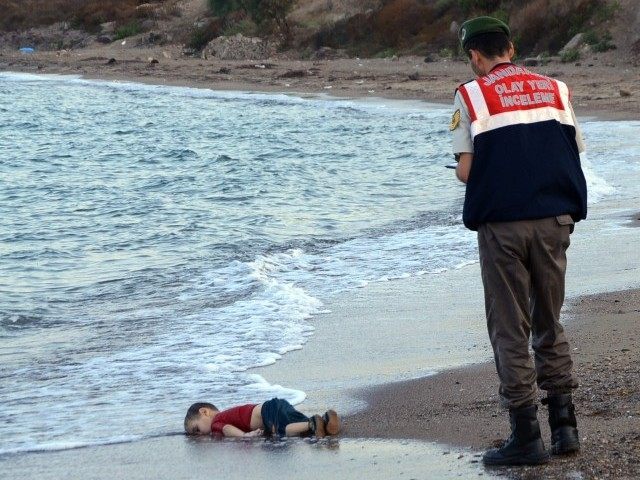The photo of the dead 3-year-old Syrian boy on a Turkish beach is haunting.
It captures everything we don’t want to see when we tap our phones or open our newspapers: a vicious civil war, a refugee crisis, the death of an innocent.
Largely because of social media, the image of little Aylan Kurdi is hammering home the Syrian migrant crisis to the world. Aylan died along with his 5-year-old brother and their mother when their small rubber boat capsized as it headed for Greece.
“It is a very painful picture to view,” said Peter Bouckaert, who as director of emergencies at Human Rights Watch has witnessed his fair share of painful scenes. “It had me in tears when it first showed up on my mobile phone. I had to think hard whether to share this.”
But share, he did. Bouckaert, who is in Hungary watching the crisis unfold, said people need to be pushed to view the “ghastly spectacle” so they can, in turn, prod governments into helping the suffering Syrian people.
Still, will the disturbing image galvanize people into action? Will it be like other seared-in-our-memory photographs — a vulture hovering over starving child in Sudan, a girl fleeing a napalm attack in Vietnam, the child in a firefighter’s arms after the Oklahoma City bombing?
Or will it become just another of the many images on social media, lost amid the flotsam?
“One of the things about this story is that it’s really difficult sometimes for the world to get a handle on it,” said Al Tompkins, a senior faculty member at the Poynter Institute, a center for media studies in St. Petersburg, Florida. “Regardless of the technology, a singular iconic image can still touch us in ways. It’s a throwback to an old storytelling form. It’s 150-year-old technology. It’s just so interesting in a fast-moving society that still it’s the power of a singular image that shakes us. That becomes the iconic defining moment that forces us to do something.”
And that singular image is often of a child. That was the cold fact that unsettled people around the globe.
Kathleen Fetters-Iossi, a 47-year-old fiction writer from West Bend, Wisconsin, said she hopes people share the images to create awareness, then go beyond that to try to help in some way. Which is admittedly difficult, she said.
“Most Americans, if they’re just now becoming aware of this issue, will ultimately feel there’s nothing we can do,” she said. “They feel like we can’t handle our own immigration problem, let alone Europe’s. Social media can help by creating wider awareness, but ultimately, ‘clicktivism’ didn’t help the Nigerian girls, and it’s not going to help those migrants.”
Walter Fradkin, a 63-year-old accountant in Buenos Aires, said he was moved by the picture of the dead boy on the front page of Argentina’s Clarin newspaper. But he said that among many Argentines, “there’s a feeling of impotence because we believe there’s little we can do since we’re so far away and the crisis in Syria has been going on for years.”
The photo was splashed on the front of all major newspapers in Brazil, a nation with more homicides than any other, according to the United Nations, and a place where the media commonly carry graphic images of drug violence. Still, the picture of the body washed up on the sand ignited despair and indignation.
“I’m speechless. It’s shocking, the absurdity of this little boy’s death,” Ary Cordovil, a 35-year-old barber, said as he looked at the photo on the cover of the working-class Extra newspaper.
Cordovil said he lives near one of Rio de Janeiro’s slums, where a drug gang war has meant nobody leaves home after dark and schools have been shut for weeks.
“I’m used to violence. Brazil is used to seeing violence. But this — this is just painful,” he said, staring hard at the image. “He’s just a baby trying to flee a war. The absurdity of this is extreme even for us.”
It inspired people like a 52-year-old grandmother from Australia to tweet multiple versions of the story.
“If these images of a dead child don’t change our attitude to refugees, what will?” tweeted Jenny Fawcett of Warrnambool, Australia. Her daughter started a petition calling on the Australian government to help more Syrian refugees.
Fawcett wrote in an email: “No child should die so young, so cruelly. It’s just wrong, wrong, wrong.”
While the image of the body on the sand was on many international websites, many U.S. sites ran a photo of a Turkish police officer carrying the limp boy in his arms. The boy’s face is obscured.
Mike Wilson, editor of The Dallas Morning News, decided to run the photo of the officer carrying the boy. He received an email from a reader who said the picture was “gory.”
“I wrote back and told her that I appreciated her sensitivity,” he said. “We chose it specifically because it wasn’t gory. There was no blood, no person’s face, no severed limbs. It’s just a forlorn, heartbreaking image that tells the reality of what’s happening.”
___
Associated Press reporters Brad Brooks in Rio de Janeiro and Almudena Calatrava in Buenos Aires contributed to this report.
___
Follow Tamara Lush on Twitter at http://twitter.com/tamaralush

COMMENTS
Please let us know if you're having issues with commenting.